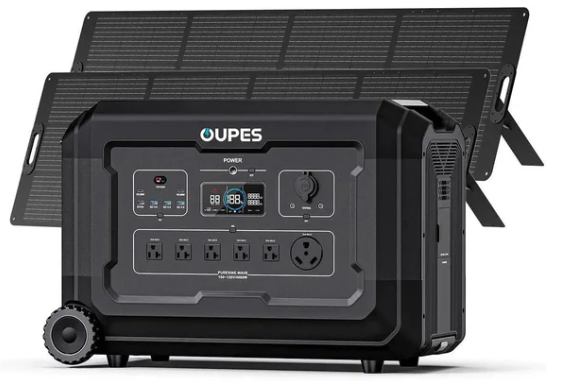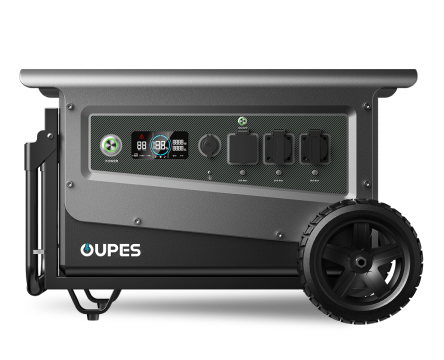
Overview
Solar cell energy storage—usually in the form of home battery banks or portable solar generators—has become a critical asset for emergency preparedness. As natural disasters, power grid failures, and extreme weather events become more frequent, communities increasingly rely on renewable backup solutions to maintain essential power.
According to the U.S. Energy Information Administration (EIA), the average American experienced over 5 hours of power interruptions in 2022, with outages becoming longer and more severe due to storms, heat waves, and infrastructure vulnerabilities. This makes solar-backed power storage one of the most resilient and reliable technologies available today.
This article explores how solar cell energy storage works, why it is uniquely suited for crisis scenarios, and how portable power stations—such as those offered by OUPES—support emergency readiness for households, RV users, and off-grid living.
Why Solar Energy Storage Matters During Crises
Increasing Frequency of Grid Failures
Climate-related disasters—wildfires, hurricanes, winter storms—are placing unprecedented strain on power infrastructure. When the grid collapses, fuel shortages and damaged transmission lines make restoring electricity challenging. Solar energy storage offers an independent, self-generating backup source that does not depend on external fuel supply chains.
Critical Need for Electricity-Dependent Devices
During crises, essential tools require consistent power:
- Communication devices (phones, radios, satellite units)
- Medical equipment (CPAP machines, refrigeration for medications)
- Refrigeration for food preservation
- Lighting and emergency signaling devices
- Water pumps and filtration systems
Solar-powered systems provide stable electricity when traditional sources fail.
How Solar Cell Energy Storage Works
1. Solar Panels Capture Sunlight
Photovoltaic cells convert solar radiation into direct current (DC) electricity. Modern panels reach conversion efficiencies of 18–22%, according to data from the National Renewable Energy Laboratory (NREL).
2. Charge Controller Regulates Power
A charge controller—often MPPT for high efficiency—ensures that the battery receives stable and optimized charging without overcharging.
3. Battery Bank Stores the Energy
Most modern systems use LiFePO4 (Lithium Iron Phosphate) batteries due to their long life cycles, thermal stability, and safety. These batteries store solar energy for later use.
4. Inverter Converts DC to AC Power
Most household appliances require AC power. A pure sine wave inverter delivers clean, stable electricity safe for sensitive electronics.
5. Power Is Supplied to Loads
During a crisis or power failure, the stored energy is used to keep essential equipment running. Portable systems offer multiple outputs, including AC, DC, USB-A, and USB-C ports.
Key Advantages of Solar Storage in Emergencies
1. Independence From Fuel Supply Chains
Gas generators rely on fuel, which often becomes scarce or unavailable during disasters. Solar storage systems recharge using sunlight, making them completely self-sufficient.
2. Long-Term Power Availability
As long as sunlight is available, a solar generator can recharge indefinitely—ideal for prolonged outages or remote locations where power restoration may take weeks.
3. Silent, Non-Polluting Operation
Solar energy systems produce no fumes, noise, or carbon emissions. This makes them suitable for indoor use, shelters, urban environments, and RVs during emergencies.
4. Safe for Indoor Use
Unlike combustion engines, solar-powered systems do not emit carbon monoxide, a leading cause of death during storm-related generator use, according to CDC reports.
5. Scalable and Flexible
From small power stations for mobile devices to large systems capable of powering home appliances, solar storage adapts to different crisis scenarios.
6. Reliable Battery Technology
LiFePO4 batteries can exceed 3500 cycles, offering over 10 years of dependable performance—crucial for long-term emergency preparedness.
7. Works Even When the Grid Is Down
Grid-tied rooftop solar alone cannot supply power during outages. With battery storage, solar becomes an effective emergency power system.
Solar Storage vs. Traditional Backup Solutions
| Feature | Solar Backup Batteries | Gas Generators |
|---|---|---|
| Fuel Requirement | None — powered by sunlight | Requires gasoline or propane |
| Indoor Use | Safe, zero emissions | Not safe — carbon monoxide risk |
| Noise Level | Silent | Loud (70–90 dB) |
| Emergency Longevity | Unlimited with sun | Limited by fuel availability |
| Maintenance | Minimal | Regular engine maintenance required |
| Environmental Impact | Clean and renewable | Emits CO₂ and fumes |
This comparison highlights why solar cell energy storage is increasingly considered a superior solution for crisis resilience.
Real-World Crisis Applications
1. Earthquakes
Earthquakes can damage fuel pipelines, electrical grids, and transportation routes. Solar power stations remain functional because they operate independently from all external infrastructures.
2. Hurricanes & Tropical Storms
Storms frequently cause week-long blackouts. Solar generators can recharge daily and power refrigeration, medical devices, and communication tools throughout the outage.
3. Wildfires
Smoke and evacuations disrupt fuel access. Portable solar storage supports emergency travel and device charging for evacuation communication.
4. Winter Grid Failures
Freezing weather can shut down power plants and freeze fuel supplies. Solar-power storage remains operational when traditional systems fail.
5. Remote or Off-Grid Crisis Situations
In remote areas with no grid access, solar energy storage becomes the only dependable electricity source.
How Portable Solar Generators (e.g., OUPES) Support Crisis Readiness
Portable solar generators combine a battery, inverter, charge controller, and multiple power outputs into a compact, user-friendly unit. Brands such as OUPES provide LiFePO4-based power stations that support home backup, RV travel, and emergency response scenarios.
Benefits of Portable Solar Generators During Crises
- Easy to transport during evacuations
- Can power essential home appliances (refrigerators, CPAP, routers)
- Compatible with foldable solar panels for continuous power
- Safe to operate indoors
- High surge output for appliance start-up
While this article remains strictly educational, OUPES serves as a practical example of how modern solar technology is applied to real-world crisis preparedness.
How to Choose a Solar Energy Storage System
1. Battery Capacity (Wh)
Higher capacity equals longer runtime. For emergency kits, 1000–3000Wh is ideal.
2. Output Power (W)
Determines which appliances can be powered. For crises, 1500–4000W is suitable for most home essentials.
3. Battery Chemistry
LiFePO4 offers the safest and longest-lasting performance for emergency scenarios.
4. Solar Input Capacity
Higher solar input means faster recharging during ongoing crises.
5. Portability
Compact and wheeled systems are ideal for evacuation or rapid deployment.
6. Output Port Variety
A mix of AC, DC, USB-A, USB-C, and Anderson ports increases flexibility.
FAQ
1. Can solar energy storage really replace a gas generator in emergencies?
For many users, yes. Solar systems are safer, cleaner, and can operate indefinitely as long as sunlight is available.
2. Do solar batteries work during cloudy weather?
Yes, though charging speed is reduced. High-efficiency MPPT controllers optimize charging even in low light.
3. Are solar generators safe for indoor use?
Absolutely. They produce no fumes, unlike combustion generators, making them ideal for shelters and homes.
4. How long do LiFePO4 batteries last?
Typically over 3500 cycles, or more than 10 years depending on use.
5. Can solar batteries power large appliances?
Yes—high-output systems can run refrigerators, medical devices, communication equipment, and more.
6. Is solar energy storage cost-effective?
Over time, solar storage reduces dependency on fuel and grid electricity, making it both economical and sustainable for emergency readiness.




























